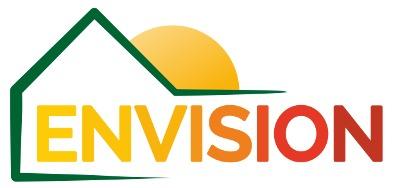ENVISION has received funding from the European Union’s Horizon 2020 research and innovation programme under grant agreement No 767180.
Started on 1st October 2017, the project’s ambition is to use of the full external building surface to harvest the maximum amount of solar radiation, thus obtaining energy positive buildings.
This is theoretically very simple, as sufficient solar energy reaches the building during a whole year.
The challenge of ENVISION Project Consortium (comprising 13 international partners: TNO as the project coordinator, AkzoNobel, Imperial Chemical Industries, BAM, EDF, Pilkington Netherlands, RINA, Bergamo Tecnologie, Università degli Studi di Genova, Vestia and Emergo) is to convert and store solar energy so that it can be efficiently used.
What type of energy do we need?
It is well known that about 60% of the energy needed in the Built Environment is for heating. Considering that going all electric will require a 60% increase of the energy demand on the electricity grid, Europe’s awareness that this requires major investment in the electricity grid is rapidly increasing.
For this reason, application of photovoltaic solar panels and/or collectors has increased considerably in recent years, but they are mainly applied on roofs due to aesthetics, practical reasons and price.
Efficiently managing solar radiation on buildings, exploiting all surfaces of the building skin, can provide an enormous potential, since in EU a total of 60 billion square meters of façade surfaces exists, and the current usage of solar radiation on vertical surfaces (both opaque and transparent) is still minimal.
Together with roofs, this would mean a total of 120 billion square meters of potential.
What is the required amount of energy?
The required amount of energy of a building strongly depends on its insulation level. This is why the ENVISION Project focuses not only on developing energy harvesting technologies, but also on putting an insulation shell around the building, reducing in this way the energy use. In a typical row dwelling in the Netherlands the energy use after insulation is around 7 GJ for tap water and 7 GJ for heating.
In addition, it was calculated that a South facing façade in the Netherlands has a harvesting potential of almost 3 GJ/m2 . With a 90% absorption, 6 m2 would be sufficient to supply all the heat needed.
Unfortunately, it is not so simple as storage is needed to match demand and supply, but the storage can be reduced by increasing the surface area.
The project
ENVISION consists in a full renovation concept that harvests energy from ALL building surfaces, both transparent and opaque.
In particular, ENVISION will develop four innovative technologies:
- Solar heat collectors based on the usage of NIR absorbing coloured coatings: the covered and uncovered colored heat harvesting façade elements are designed in such a way that a maximum energy with retaining aesthetics are achieved
- Covered solar heat collectors using colored NIR transparent glasses: colored glass is provided with high transmission features to obtain nice aesthetic properties combined with high energy storage
- Smart ventilated heat harvesting window: the ventilated glass solution will harvest heat from the infrared part of the solar radiation. In the summer mode, the heat is harvested via a heat exchanger, to be used whenever needed. In winter mode, the air is heated and directly used in the inside
- PV harvesting glasses: PV glass with transparent appearance and improved efficiency that harvest electricity from the PV part of the glass
The ENVISION solutions will be tested by the consortium partners in two large scale demonstrations in Delft the Netherlands, and Savona, in Italy. In the first demonstration, they will renovate an apartment flat, and in the second demonstration, they will connect the heat harvesting panels with a heat pump to a heating grid.
Advantages for the EU community
The innovative technologies developed in the framework of the project will enable the use of the maximum of façade surface to harvest energy while retaining the aesthetic environment (architecture etc.) of buildings and be characterised by a higher energy performance compared with current commercial solutions.
Moreover, ENVISION technologies will be easy to install and implement (<2 days installation time), cost-effective (payback <10 years) and reduce the load on the electrical grid
Visit the project website to learn more: http://www.energy-envision.eu/




